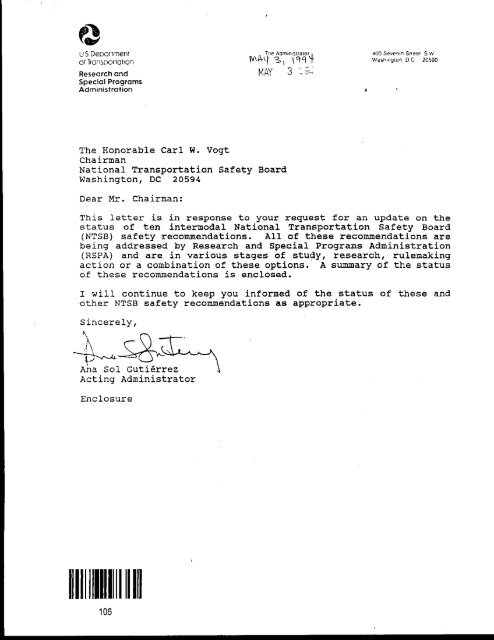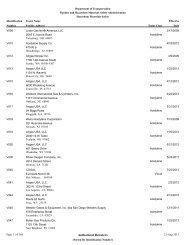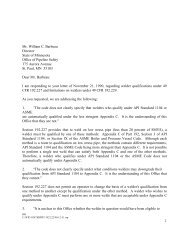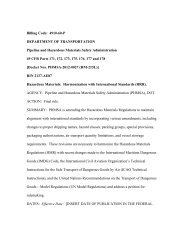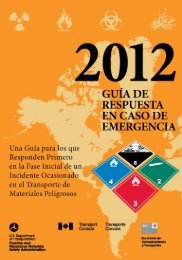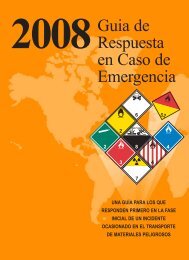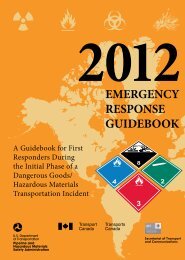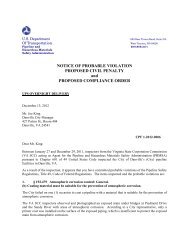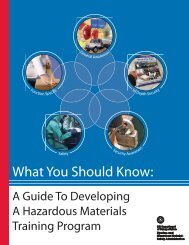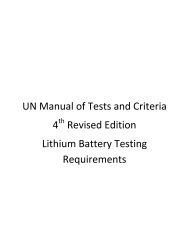The Honorable Carl W. Vogt Chairman National Transportation ...
The Honorable Carl W. Vogt Chairman National Transportation ...
The Honorable Carl W. Vogt Chairman National Transportation ...
You also want an ePaper? Increase the reach of your titles
YUMPU automatically turns print PDFs into web optimized ePapers that Google loves.
US Deportment<br />
or lrorisporlol~on<br />
Research and<br />
Special Programs<br />
Administration<br />
<strong>The</strong> <strong>Honorable</strong> <strong>Carl</strong> W. <strong>Vogt</strong><br />
<strong>Chairman</strong><br />
<strong>National</strong> <strong>Transportation</strong> Safety Board<br />
Washington, DC 20594<br />
Dear Mr. <strong>Chairman</strong>:<br />
This letter is in response to your request for an update on the<br />
status of ten intermodal <strong>National</strong> <strong>Transportation</strong> Safety Board<br />
(NTSB) safety recommendations. All of these recommendations are<br />
being addressed by Research and Special Programs Administration<br />
(RSPA) and are in various stages of study, research, rulemaking<br />
action or a combination of these options.' A summary of the status<br />
of these recommendations is enclosed.<br />
I will continue to keep you informed of the status of these and<br />
other NTSB safety recommendations as appropriate.<br />
Sincerely,<br />
ha Sol Gutigrrez I<br />
Acting Administrator<br />
Enclosure
Statusfof T<br />
I-81-3 recommends that RSPA develop and use a common shipper identifier in all<br />
DOT hazardous materials compliance records. RSPA in coordination with a<br />
Departmental working group has designed and daveloped a shipper data system<br />
called UNISHIP, which assigns a unique five-digit identification number to each<br />
shipper and contains a history of shipper performance including inspection and<br />
enforcement actions. Each shipper entry is also cross-refereneed to eachmodal<br />
administration shipper identification number. <strong>The</strong> data are accessible by each<br />
administration who can use their individual identifier for the shipper. <strong>The</strong><br />
system has been successfully demonstrated and we consider it operational<br />
including use of the common shipper: identification number. We believe that<br />
these actions are responsive to safety recommendation 1-81-3 and request that<br />
this recommendation be reclassified as "Closed-Acceptable Actionm.<br />
I-83-G recommends that RSPA develop preshipment inspection criteria for drums<br />
being reconditioned for reuse to assist shippers and carriers in complying with<br />
the requirements of 49 CFR Sections 171.2(a) and 173.24(a). HM-181 sets<br />
performance standards for drums which must be capable of meeting the performance<br />
standards specified in subpart M of part 178 for the applicable packing group<br />
shown in column 5 of the Hazardous Materials Table (Section 172.101). We<br />
believe that the need for development of preshipment criteria for drums has been<br />
superseded by the new performance-oriented requirements set forth in HM-181.<br />
We, therefore, request that 1-83-4 be classified as 'Closed-Acceptable<br />
A1 ternative Action".<br />
-1-87-4recommends that RSPA require thermal protection for those explosive<br />
shipments that pose the greatest fragment and overpressure hazards in highway<br />
transportation accidents. RSPA has been analyzing various options to address<br />
the thermal protection issue. Some of the options include the use of thermal<br />
retardant materials, as well as special training requirements for drivers<br />
involved in the transportation of explosives. We will keep you informed of our<br />
progress in this area and request that 1-87-4 be classified as "Open-Acceptable<br />
Action".<br />
I-87-5 recommends that RSPA establish evacuation distances for explosives beyond<br />
2,500 feet and require that vehicles transporting such shipments of explosives<br />
be properly identified to inform emergency responders about the increased<br />
hazards and. the recommended evacuation distances. Evacuation. distances have<br />
been addressed in the 1990 edition of the ERG and are being updated and expanded<br />
in the 1993 edition of the ERG. HM-181 provides a new classification system<br />
which assigns explosives to six divisions that provide emergency responders with<br />
sufficient information on the hazards of the explosives. <strong>The</strong> division<br />
classification appears on the new placards and will identify those explosives<br />
which have a mass explosion hazard, a projection hazard, or a predominantly fire<br />
hazard and those with no significant blast hazard. We believe that these<br />
actions are responsive to the objectives of 1-87-5 and request that this<br />
recommendation be classified "Closed-Acceptable Action".
I-90-5 recommends that RSPA require all manufacturers of DOT specification<br />
containers to retest randomly selected containers and to notify owners of<br />
containers in lots that fail the tests to remove DOT specification markings.<br />
As recommended by NTSB in their response to RSPA's proposed action, a draft of<br />
written procedures is being developed which will formalize and strengthen the<br />
process of dealing with DOT specificationpackagings that were not tested, were<br />
improperly tested, or failed required tests. RSPA has always assessed the<br />
safety imp.licationofnon-compliance and actedquicklywhensafetywas affected.<br />
<strong>The</strong>refore, we see no need to retroactively evaluate past actions as proposed by<br />
NTSB. We expect to formalize the written procedure in the near future and will<br />
keep you apprised of our actions.<br />
1-90-6 recommends that RSPA modify the compliance program to determine that<br />
containers are removed from transportation when those containers are identified<br />
as not meeting specification requirements. Action on this recommendation has<br />
been combined with the process outlined under safety recommendation 1-90-5. In<br />
this process, cylinders that do not meet the regulatory requirements will be<br />
allowed to continue in transportation if it is determined that minimal non-<br />
compliance was involved and only a minimal hazard exists. Our records do not<br />
indicate that cylinders posing a minimal hazard are a major factor in causing<br />
serious accidents. We understand your concern to ensure that every cylinder is<br />
transported safely under every contingency. However, there are non-compliance<br />
incidents that have little or no effect on safety (e.g., failure to retain test<br />
samples) and should be more appropriately handled by a civil penalty than a<br />
recall of the containers. <strong>The</strong> fact that a company tests its packagings, but<br />
fails to test them properly, is not prima-facie evidence that the packaglngs are<br />
bad or inadequate. It could indicate that the company is lax in its procedures,<br />
which may warrant a civil penalty action, but not necessarily a recall. Also,<br />
in many cases recall is impractical because the containers are not traceable.<br />
We are developing a definition of "minimal hazard" which will relate to 'real<br />
world" situations involving the transportation of hazardous materials in DOT<br />
specification cylinders. This definition will provide sufficient guidelines to<br />
ensure that cylinders that pose a serious threat to public safety will be<br />
recalled.<br />
I-90-8 recommends that RSPA require that hazardous materials be secured in<br />
transportation with adequate cargo restraint systems, In our analysis of the<br />
various factors involved in addressing this recommendation, the cost impact of<br />
using restraint systems, including webs and straps, could have serious financial<br />
consequences for the many small companies involved. In order to receive the<br />
necessary economic and operational informat:ion to properly study the cargo<br />
restraint system area, we are including this recommendation in a "notice of<br />
petitions for rulemaking received and other recommendations for rulemaking"<br />
(including NTSB recommendations) which is currently under development. WF<br />
expect to publish this notice in the Federal Register by the end of this year.<br />
<strong>The</strong> notice will request information in the following areas: 1) estimated<br />
incremental costs and savings; 2) anticipated safety benefits or increased<br />
risks: 3) estimated burden hours associated with proposals related to<br />
information collection; 4) impact on small businesses; and 5) impact on the<br />
national environment. Since RSPA is collecting relevant data and analyzing the '<br />
use of restraint systems for securing cylinders during the transportation of<br />
hazardous materials, we request that 1-90-8 be reclassf fied from "Open-<br />
Unacceptable Action" to "Open-Acceptable ~ctiod".
1-90-9 recommends that RSPA require independent inspections of new and<br />
reconditioned low pressure cylinders that are consistent with the present<br />
independent inspection requirements for high pressure cylinders. To properly<br />
address the recommendation, RSPA needs specific economic and operational data<br />
from industry. Accordingly, RSPA is developing an ANPRH to address this Class<br />
111 Longer Term Action recommendation and expects publication this year.<br />
1-90-10 recommends that RSPA amend inspection and testing requirements for<br />
pressure cylinders to make the requirements clear and consistent. Because of<br />
the lack of available coat information in this area, RSPA has decided to publish<br />
an MPRM rather than an NPM as originally planned. RSPA has begun drafting the<br />
ANPRM which will focus on high pressure cylinders and solicit industry inputs<br />
on costs, operations, and safety benefits.<br />
1-90-11 recommends that RSPA develop and implement requirements for improving<br />
the visibility and effectiveness of hazardous materials placards, and that<br />
consideration be given to the position of vehicles after accidents. RSPA is<br />
addressing this recommendation under Docket HM-206, Improving Hazardous<br />
Materials Identification Systems. <strong>The</strong> location, attachment and type of placard<br />
is being addressed and will take into consideration the position of the vehicle<br />
after an accident. <strong>The</strong> ANPRM was published in June, 1992, and the NPRM is under<br />
development and planned for publication during the first half of this year.<br />
Because of these actions, RSPA requests that I-90-llbe reclassified from "Open-<br />
Unacceptable Action" to "Open-Acceptable Action*.
U.S. Department of <strong>Transportation</strong><br />
Research and Special Programs Administration<br />
Office of Hazardous Materials Safety<br />
procedure for Removal of Nonconforming Hazardous Materials<br />
Packagings from Service, 7-13-95<br />
'I<br />
When a nonconforming packaging is identified, including during<br />
the course of an inspection or investigation, the Research and<br />
Special Programs Administration's (RSPA's) Office of Hazardous<br />
Materials Enforcement (OHME) will collect all available data on<br />
the manufacturing process and the performance of the packaging.<br />
In consultation with the Office of Hazardous Materials Technology<br />
(OHMT) and the Office of Chief Counsel (OCC), the OHME will make<br />
an initial assessment of the hazard and risk presented by the<br />
nonconforming packagings using criteria in Appendix A, Assessment<br />
Guidelines for Nonuonforming Packagings. Should inadequate<br />
information be available to make an initial assessment, OHME will<br />
request the alleged violator to take immediate to develop .<br />
the information necessaqy to make an a'ssessment of the hazard and<br />
risk presented by the nonconforming packaging. At a minimum,<br />
such actions must include testing of random samples of the<br />
nonconforming packaging and analysesof potentia1,variance in<br />
packaging properties and performance.: Based upon the initial<br />
assessment.of hazard and risk, OHME will determine the<br />
appropriate action that will be taken, based on the following:<br />
1. If an "imminent hazarda exists (i.e., there is a substantial.<br />
probability that death or serious injury will occur from<br />
frequent worker or public exposure to hazardous materials or<br />
frequent packaging failures), OHME will request immediate<br />
action by the alleged violator to remove the packagings from<br />
service or other action to ameliorate the hazard presented<br />
by the suspect packagings. OCC will initiate action under<br />
Section 49 U.S.C. 5122 of the Hazardous Materials<br />
<strong>Transportation</strong> Laws if necessary to eliminate or ameliorate<br />
the imminent hazard. In addition, RSPA will publish an<br />
appropriate notice in the Federal Register and other<br />
appropriate publications about the defective packagings, if<br />
deemed necessary to protect the public. Finally RSPA will<br />
initiate appropriate enforcement action, through OCC, as<br />
described below in paragraphs 2 and 3.<br />
2. If a "lesser hazard" exists, RSPA will request that the<br />
alleged violator take appropriate and timely corrective<br />
act ion. Such action. may include additional analysis and/or<br />
testing to determine the nature and extent of the problem<br />
and costs and consequences of actions including removal of<br />
packaging.from service, retrofitting, derating, operational<br />
controlls:and notification to customers. Publication in the
Federal Register and other publications will be determined on a<br />
case-by-case basis. RSPA will initiate appropriate enforcement<br />
action, through OCC, which may include a compliance'order under<br />
Section 109(a) of the hazardous materials transportation laws or<br />
withdrawal of an exemption or approval (if applicable).<br />
3. If "veryminimal or no hazard" exists, OHME will initiate<br />
appropriate enforcement action through OCC. ,<br />
#
Appendix A, Assessment Guidelines for Nonconforming Packagings<br />
Based upon the type of noncompliance and its consequence,<br />
packagings manufactured in.noncompli,ance with their specification<br />
may or may not be uhsafe for service. DOT Specifications often<br />
coctain substantial factors of safety to provide a margin of<br />
safety, allow for unknown and unexpected factors and<br />
unintentional variations in manufacture, and provide long package<br />
life. In addition, many packagings are often operated below<br />
their design conditions which provides an addition factor of<br />
safety and reduced public risk when operated in such a manner.<br />
For example, welded low pressure cylinders are often used to<br />
transport materials with a vapor pressure well below the service<br />
pressure of the cylinder, thus adding an.additiona1 factor of<br />
safety to that built into the specification. For these reasons,<br />
a hazard and risk assessment must be performed on a case-by-case<br />
basis. In consideration of safety factors built into<br />
specification packagings, a variation of 5% or less ,from values<br />
for material properties, test conditions, acceptance criteria,<br />
minimum wall thickness, or marked values are of very minimal or<br />
no safety hazard.<br />
Recalls of packagings or removal of specification or exemption<br />
markings from a large group of packagings, thereby prohibiting<br />
their use in hazardous materials service, is a very serious<br />
action with potentially very large economic and safety<br />
consequences. Such actions should be taken only when the impact<br />
of such actions is understood and taken into consideration. Such<br />
actions can often bankrupt a manufacturer and a number of its<br />
customers or create health and safety problems greater than they<br />
alleviate. A risk assessment matrix and a risk index are<br />
provided to give guidance in relating failure consequence and<br />
frequency of occurrence and in ranking the resultant risk (Figure<br />
1). <strong>The</strong> following are factors that must be considered when<br />
assessments of hazard, risk and recall or safety countermeasures<br />
are performed:<br />
1. What is the expected failure mode? RuptQre, leakage,<br />
permanent expansion or reduced performance in an accident<br />
environment?<br />
2. What are the hazards and consequences of the expected<br />
package failure modetand of the release of the hazardous<br />
materials transported?<br />
3. How many packagings are involved and in what service are<br />
they used?<br />
4. What is the worker and public exposure to the subject<br />
packagings?<br />
5. What is the likely packaging failure rate resulting from the<br />
package defect? How does this rate compare.to other package<br />
and transportation system failure rates?
6. Are alternative packagings available? Alternative<br />
packagings are often not available for many exemption or<br />
specialized packagings.<br />
7. What are the safety consequences of removing packagings from<br />
service? Many hazardous materials and packagings provide<br />
health and safety benefits for society. Removal of such<br />
materials or packagings, particylarly when no or few<br />
alternatives are available, may create greater health and<br />
safety risks than those alleviated by removing nonconforming<br />
packagings. A large increase in trips or the number of<br />
alternative packagings can increase the probability of .<br />
deaths and injuries from increases in transportation,<br />
loading, and unloading accidents.<br />
8. What are the economic impacts of removing packagings from .<br />
service on packagings manufactures, shippers and end users<br />
of the packaging or materials transported?<br />
9. What other options are available? Derating, operational<br />
controls, retrofit, or phased removal from service?<br />
10. What are the best methods of reaching persons who possess<br />
nonconforming packagings? What is the probability of<br />
success?<br />
A defect should be considered an "imminent hazard1* when there is<br />
a substantial probability that death.'or serious injury will 'occur<br />
from frequent worker or public exposure and frequent packaging<br />
failures. An imminent hazard requires immediate public<br />
notification of the hazard and initiation of actions to eliminate<br />
or ameliorate the imminent hazard.<br />
#
Occurrence<br />
RISK INDEX:<br />
RISK ASSESSMENT MATRIX<br />
IA, IB, IC, IIA, IIB, IIIA U UNACCEPTABLE<br />
ID, IIC, IIIB, IVA C-MDR CONDITIONAL - MANAGEMENT<br />
DECISION REQUIRED<br />
IE, IID, IIIC, IVB, IVC A- MRR ACCEPTABLE - MANAGEMENT<br />
VA, IVB, VB, REVIEW REQUIRED<br />
IIIE, IVD, IVE, VC, VD, VE A ACCEPTA9LE<br />
Figure 1. RISK ASSESSMENT MATRIX AND RISK I XEX


